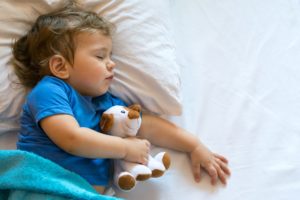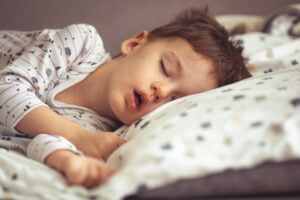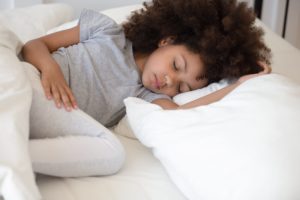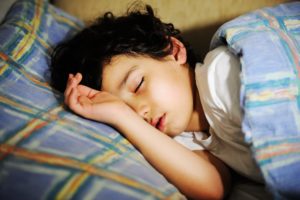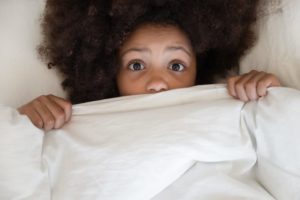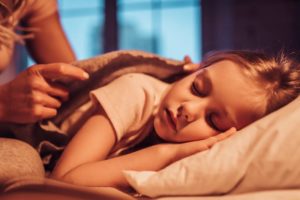When you buy through our links, we may earn a commission. Products or services may be offered by an affiliated entity. Learn more.
Summer Sleep Routines for Kids
As the school year wraps up, and kids and teens enter summer break, their schedules usually become much less rigid. As a result, consistent sleep tends to suffer. Also, longer daylight hours provide more opportunities to spend time outdoors in the evening, which can interfere with sleep. Finally, summer vacations are another factor that might throw your kid’s sleep schedule off-balance.
Summer sleep deprivation could potentially lead to more serious problems for kids. Insufficient sleep is likely a risk factor for type 2 diabetes in kids and teens. Kids who sleep less have worse cardiometabolic health , as measured by larger waistlines, higher blood pressure, and lower levels of “good” cholesterol in the blood. In adolescents, receiving inadequate sleep may play a role in depressive symptoms . Also, poor sleep quality and lack of sleep are related to learning and memory problems in both children and adolescents.
Unfortunately, summertime sleep disruption is virtually inevitable for most children. However, that doesn’t mean you’re helpless against its negative effects. In fact, the more knowledgeable parents are about children and sleep, the better sleep their children receive. There are many simple actions you can take to help protect your children and teens against the consequences of summertime sleep disturbances.
Maintain a Consistent Sleep Schedule
Children tend to maintain later sleep and wake times when they don’t have to go to school the next morning. This trend is even more pronounced in adolescents, who naturally have later bedtimes as they get older, even when they have to wake up early the next morning. For these reasons, you might want to adjust your children’s sleep schedules to allow them to stay up later during the summer. Still, this later bedtime should remain consistent from night-to-night and their wakeup time should become later too, to ensure they still get enough sleep.
A consistent bedtime routine can help promote a consistent sleep schedule. About an hour before bed, encourage your child to start their bedtime routine. This routine might include changing into pajamas, brushing teeth, dimming the lights, and reading a bedtime story. Older children and adolescents might not want a bedtime story, but they can read in bed or do gentle stretches to relax. Make sure they stop using devices during this time — smartphones, tablets, and TVs emit blue light that can interfere with sleep.
Help Your Child Sleep Better With Pediatric Sleep Coaching
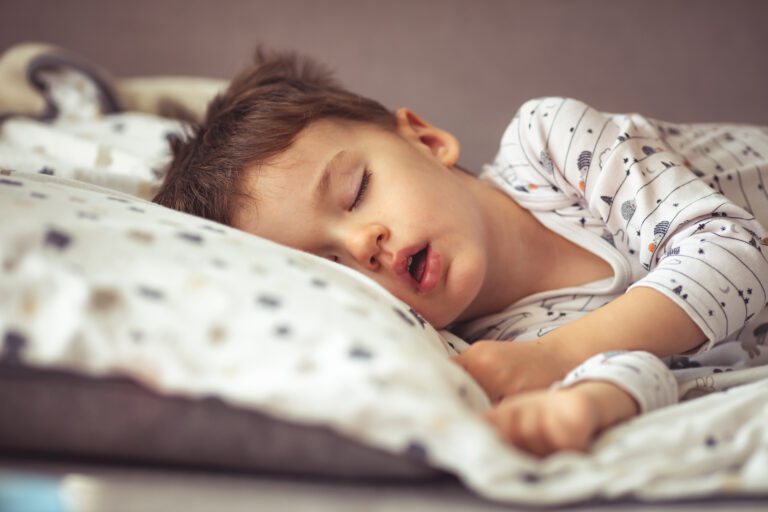
our partner at sleepdoctor.com
Learn More“Life-changing! My anxiety about my son’s sleeping habits were immediately reduced after talking to Sara. She went above and beyond to tailor a schedule to our goals, answer our questions, keep us on track, and check in to encourage us when we just thought we couldn’t do it anymore.”
Rachael B. – Verified Customer
Promote Healthy Daytime Habits
Though summer brings more unstructured time than other times of the year, it is important to maintain some of the same habits, as daytime behavior affects how well people of all ages sleep at night. For example, the more physically active children are during the day, the more quickly they fall asleep at night. Although dietary factors need further study to provide conclusive information, it appears healthier diets likely promote better sleep . Encourage your kids to engage in physical play or exercise daily, as well as eat healthy foods like fruits, vegetables, and whole grains.

Keep the Bedroom Cool and Dark
An important part of summertime sleep hygiene is adjusting bedroom conditions to fit the season. In many locations, summer months are sunnier and hotter. To keep sunshine from waking your child up too early in the morning, consider investing in blackout curtains. These curtains keep any light from coming in. If those aren’t feasible, an eye mask is another option for blocking out potentially disruptive light. Also, with longer days, consider transitioning inside, out of daylight, in the hour before bed. This will cue your body that it’s time to prepare for sleep.
Turning on a fan or the AC could also help create ideal summer sleep conditions for your kids and teens. When the temperature is too hot, people tend to experience more sleep disruptions . If you’re worried about making the room too cold, make sure your kids have bedding they can use or remove to regulate body temperature during the night.
Minimize Jet Lag and Vacation Sleep Disturbances
If you have a family vacation planned, or if you’re sending the kids off to summer camp, take efforts to make sure travel doesn’t negatively impact sleep. Let your kids bring their own pillows and blankets, if possible. These can provide emotional comfort, and also make flying or riding in a car more physically comfortable and suitable for sleeping.
If your kids will be flying into another time zone, there are steps you can take to help them limit the effects of jet lag . Consider adjusting their bedtimes a little in the days leading up to the trip, so they start becoming accustomed to staying up later or going to bed earlier, whichever they will do in the destination time zone. Once you’ve arrived, make sure they eat meals on the new time zone’s schedule, even if they’re still hungry on the old schedule. Finally, have them spend time outdoors during sunny hours, which will help acclimate the circadian rhythm to the new location’s schedule.
Prepare for Back-to-School in Advance
The disruption of summer break doesn’t only carry the risk of negatively affecting your children’s sleep during summer — it could also impact the beginning of the next school year. To avoid this, begin preparing for the new school year a week or two in advance. If your kids have been staying up and sleeping in later, begin adjusting their bedtimes gradually. That way, by the time the first day of school arrives, they should have no problem falling asleep on time and can enjoy the first day well-rested.

Still have questions? Ask our community!
Join our Sleep Care Community — a trusted hub of sleep health professionals, product specialists, and people just like you. Whether you need expert sleep advice for your insomnia or you’re searching for the perfect mattress, we’ve got you covered. Get personalized guidance from the experts who know sleep best.
References
13 Sources
-
Dutil, C., Chaput, J. P. (2017). Inadequate sleep as a contributor to type 2 diabetes in children and adolescents. Nutrition & Diabetes, 7(5), e266.
https://pubmed.ncbi.nlm.nih.gov/28481337/ -
Cespedes Feliciano, E. M., Quante, M., Rifas-Shiman, S. L., Redline, S., Oken, E., & Taveras, E. M. (2018). Objective Sleep Characteristics and Cardiometabolic Health in Young Adolescents. Pediatrics, 142(1), e20174085.
https://pubmed.ncbi.nlm.nih.gov/29907703/ -
Raniti, M. B., Allen, N. B., Schwartz, O., Waloszek, J. M., Byrne, M. L., Woods, M. J., Bei, B., Nicholas, C. L., & Trinder, J. (2017). Sleep Duration and Sleep Quality: Associations With Depressive Symptoms Across Adolescence. Behavioral sleep medicine, 15(3), 198–215.
https://pubmed.ncbi.nlm.nih.gov/26744783/ -
Dewald, J. F., Meijer, A. M., Oort, F. J., Kerkhof, G. A., & Bogels, S. M. (2010). The influence of sleep quality, sleep duration and sleepiness on school performance in children and adolescents: A meta-analytic review. Sleep Medicine Reviews, 14(3), 179–189.
https://pubmed.ncbi.nlm.nih.gov/20093054/ -
McDowall, P. S., Elder, D. E., & Campbell, A. J. (2017). Relationship between parent knowledge of child sleep, and child sleep practices and problems: A pilot study in a children’s hospital cohort. Journal of Paediatrics and Child Health, 53(8), 788–793.
https://pubmed.ncbi.nlm.nih.gov/28425627/ -
Touchette, E., Mongrain, V., Petit, D., Tremblay, R. E., & Montplaisir, J. Y. (2008). Development of sleep-wake schedules during childhood and relationship with sleep duration. Archives of Pediatrics & Adolescent Medicine, 162(4), 343–349.
https://pubmed.ncbi.nlm.nih.gov/18391143/ -
National Research Council (US) and Institute of Medicine (US) Forum on Adolescence; Graham MG, editor. (2000). Sleep needs, patterns, and difficulties of adolescents: Summary of a workshop. Washington (DC): National Academies Press (US). Adolescent Sleep Patterns and Daytime Sleepiness.
https://www.ncbi.nlm.nih.gov/books/NBK222804/ -
Touitou, Y., Touitou, D., & Reinberg, A. (2016). Disruption of adolescents’ circadian clock: The vicious circle of media use, exposure to light at night, sleep loss and risk behaviors. Journal of Physiology, Paris, 110(4 Pt B), 467–479.
https://pubmed.ncbi.nlm.nih.gov/28487255/ -
Nixon, G. M., Thompson, J. M. D., Han, D. Y., Becroft, D. M. O., Clark, P. M., Robinson, E., Waldie, K. E., Wild, C. J., Black, P. N., & Mitchell, E. A. (2009). Falling asleep: The determinants of sleep latency. Archives of Disease in Childhood, 94(9), 686–689.
https://pubmed.ncbi.nlm.nih.gov/19633062/ -
St-Onge, M. P., Mikic, A., & Pietrolungo, C. E. (2016). Effects of diet on sleep quality. Advances in Nutrition, 7(5), 938–949.
https://pubmed.ncbi.nlm.nih.gov/27633109/ -
Obradovich, N., Migliorini, R., Mednick, S. C., & Fowler, J. H. (2017). Nighttime temperature and human sleep loss in a changing climate. Science Advances, 3(5), e1601555.
https://pubmed.ncbi.nlm.nih.gov/28560320/ -
Okamoto-Mizuno, K., & Mizuno, K. (2012). Effects of thermal environment on sleep and circadian rhythm. Journal of Physiological Anthropology, 31(1), 14.
https://pubmed.ncbi.nlm.nih.gov/22738673/ -
National Center for Emerging and Zoonotic Infectious Diseases (NCEZID), Division of Global Migration and Quarantine (DGMQ). (2020, January 3). Jet lag. Centers for Disease Control and Prevention., Retrieved May 9, 2021, from
https://wwwnc.cdc.gov/travel/page/jet-lag






